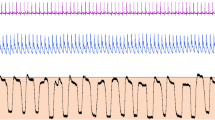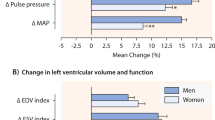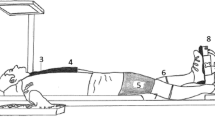Summary
This study investigated cardiovascular responses to 2 min sustained submaximal (20% MVC) and maximal (100% MVC) voluntary isometric contractions of the finger flexors in healthy young women. Cardiovascular variables investigated were: heart rate (f c), mean arterial pressure (\(\bar P\) a), and stroke volume (SV). Doppler echocardiography was used to estimate SV from measures of aortic diameter (AD) and time-velocity integrals. Preliminary studies indicated that AD did not change significantly after 2 min sustained 100% MVC. Therefore, pre-exercise AD values were used to calculate SV before, during and after exercise. During the 2-min 100% MVC period, f c and \(\bar P\) aincreased significantly during the first 30 s of contraction. f c then remained constant during the remainder of the 2-min contraction period, while \(\bar P\) acontinued to rise. SV did not change significantly during the 100% MVC task but increased significantly during recovery from sustained 100% MVC. The data suggest that the magnitude of cardiovascular responses to isometric exercise is dependent on the specific task performed, and that there is a different pattern of response for f c, \(\bar P\) a, and SV during 20% and 100% MVC tasks. Unlike f c and \(\bar P\) a, SV did not change significantly during isometric exercise, but increased significantly after sustained 100% MVC.
Similar content being viewed by others
References
Bezucha GR, Lenser MC, Hanson PG, Nagle FJ (1982) Comparison of hemodynamic responses to static and dynamic exercise. J Appl Physiol 53:1589–1593
Christie J, Sheldahl LM, Tristani FE, Sagar KB, Ptacin MJ, Warm S (1987) Determination of stroke volume and cardiac output during exercise: comparison of two-dimensional and Doppler echocardiography, Fick oximetry, and thermodilution. Circulation 76:539–547
Hanson P, Nagle F (1987) Isometric exercise: cardiovascular responses in normal and cardiac populations. Cardiology Clinics 5:157–170
Kaufman MP, Rybicki KJ, Waldrop TG, Ordway GA (1984) Effect of ischemia on responses of group III and IV afferents to contraction. J Appl Physiol 57:644–650
Lewis SF, Snell PG, Taylor WF, Hamra M, Graham RM, Pettinger WA, Blomqvist CG (1985) Role of muscle mass and mode of contraction in circulatory responses to exercise. J Appl Physiol 58:146–151
Lind AR, McNicol GW (1967) Muscular factors which determine the cardiovascular responses to sustained and rhythmic exercise. Can Med Assoc J 96:705–716
Lind AR, Taylor SH, Humphreys PW, Kennelly BM, Donald KW (1964) The circulatory effects of sustained voluntary muscle contraction. Clin Sci 27:229–244
Maciel BC, Gallo L, Marin JA, Neto JA, Martins L (1987) Autonomic nervous control of the heart rate during isometric exercise in normal man. Eur J Appl Physiol 408:173–177
Mark AL, Victor RG, Nerhed C, Wallin BG (1985) Microneurographic studies of the mechanisms of sympathetic nerve responses to static exercise in humans. Circ Res 57:461–469
McDermott DJ, Stekiel WJ, Barboriak JJ, Kloth LC, Smith JJ (1974) Effect of age on hemodynamic and metabolic response to static exercise. J Appl Physiol 37:923–926
Misner JE, Going SB, Massay BH, Ball TE, Bemben MG, Essandoh LK (1990) Cardiovascular response to sustained maximal voluntary static muscle contraction. Med Sci Sports Exerc 22:194–199
Mitchell JH (1985) Cardiovascular control during exercise: central and reflex neural mechanisms. Am J Cardiol 55:34D-41D
Mitchell JH, Schibye B, Payne FC, Saltin B (1981) Response of arterial pressure to static exercise in relation to muscle mass, force development, and electromyographic activity. Circ Res 48 [Suppl 2]:70–75
Perez-Gonzalez JF (1981) Factors determining the blood pressure responses to isometric exercise. Circ Res 48 [Suppl 2]:76–86
Perez-Gonzalez JF, Schiller NB, Parmley WW (1981) Direct and noninvasive evaluation of the cardiovascular response to isometric exercise. Circ Res 48 [Suppl 2]:138–148
Rowell LB (1980) What signals govern the cardiovascular responses to exercise? Med Sci Sports Exerc 12:307–315
Sagiv M, Goldhammer E, Abinander EG, Rudoy J (1988) Aging and the effect of increased after-load on left ventricular contractile state. Med Sci Sport Exerc 20:281–284
Saito M, Yamazaki T, Goto Y, Sumiyoshi T, Fukami K, Haze K, Hiramori K (1987) Cardiovascular responses during ordinary activities in healthy subjects: predominance of blood pressure response over heart rate in activities with isometric components. J Cardiopulmonary Rehabil 7:253–258
Shepherd JT, Blomgvist CC, Lind AR, Mitchell JH, Saltin B (1981) Static (isometric) exercise: retrospection and prospection. Circ Res 48 [Suppl 2]:179–188
Stopford JL (1988) Static exercise — physiologic dangers and proper training techniques. Nurse Pract 13:9–18
Author information
Authors and Affiliations
Rights and permissions
About this article
Cite this article
Smith, D.L., Misner, J.E., Bloomfield, D.K. et al. Cardiovascular responses to sustained maximal isometric contractions of the finger flexors. Europ. J. Appl. Physiol. 67, 48–52 (1993). https://doi.org/10.1007/BF00377704
Accepted:
Issue Date:
DOI: https://doi.org/10.1007/BF00377704




